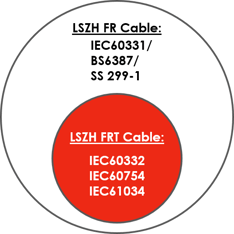What is the Difference Between FRT and FR Cable?

LSZH Flame Retardant (FRT) and LSZH Fire Resistant (FR) cable are two distinct types of cable properties, although these terms are often misused.
Flame and Fire can be used interchangeably, but confusion occurs between Retardant and Resistant. Knowing what these cable properties mean can help ensure you get the suitable cable for your application.
LSZH Flame Retardant (FRT) Cable
LSZH FRT cable is a cable that does not promote the spread of fire. But the cable will not maintain circuit integrity in the presence of fire.
The international standards on flame propagation are IEC 60332-1-2 for a single insulated wire or cable or IEC 60332-3 for vertically mounted bunched wires or cables under fire conditions.
To ensure safety during a fire, FRT cable typically uses LSZH material. LSZH produces little smoke or acidic gas when burned**, so LSZH FRT cable also undergoes acid gas emission tests to IEC 60754 or BS EN 60754 and smoke emission tests to IEC 61034 or BS EN 61034.
LSZH FRT cable is a vital cable to be used in enclosed areas with high foot traffic, such as underground passenger systems, airports, schools, hotels, hospitals, and high-rise buildings.
LSZH Fire Resistant (FR) Cable
LSZH FR cable is a fire safety product, which means it not only reduces the spread of fire, it will maintain circuit integrity in the presence of fire.
FR cable has a layer of mica tape around individual copper conductors. Mica is an incombustible natural inorganic mineral with high dielectric strength and excellent heat resistance. Hence during a fire, the mica acts as a fire barrier to the conductor and maintains circuit integrity. In addition to LSZH FRT tests (IEC 60332, IEC 60754, and IEC 61034), LSZH FR cable is also tested to IEC 60331, BS 6387 or SS 299-1. These tests cover the cable's resistance to fire, resistance to fire with water and resistance to fire with mechanical shock.
LSZH FR cable is an important cable to be used when you require critical electrical installations to perform during a fire evacuation: fire alarm systems, voice alarm systems, and emergency lighting systems.
At Keystone, we ensure that our LSZH FR cables fulfil BS 6387 Cat. CWZ provides the highest performance and safety levels for such cables.

-------------------------------------------------------
**What is Low Smoke Zero Halogen (LSZH)?
To understand the properties of LSZH, we compare it to the most commonly used cable material, PVC or polyvinyl chloride.
In the event of a fire where PVC burns, black carbon smoke and hydrogen chloride gas (HCl) are released. Black smoke impedes general vision. And when gaseous hydrogen chloride comes in contact with moisture, such as a person’s eyes, mouth, throat and nose, it dissolves to form hydrochloric acid, causing extreme irritation and choking, hindering escape.
(CH2CHCl)n + O2 → CO2 + CO + HCl + H2O
LSZH, because of inorganic additives such as aluminium hydroxide or magnesium hydroxide, releases gaseous water when burned, which helps envelop the flame and exclude oxygen from the fire. In this chemical reaction, the decomposed products are non-toxic and the mineral phases MgO and Al2O3 are alkaline, reducing the likelihood of acidic gas irritations.
When burned, LSZH also emits less optically dense smoke, thus allowing better vision and escape.
Mg(OH)2 → MgO + H2O or 2Al(OH)3 → Al2O3 + 3H2O
-------------------------------------------------------
